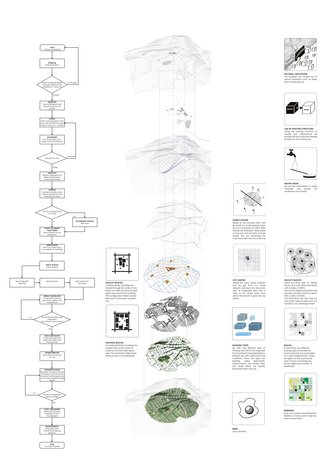SYNCITY
Parametric Master planning for Emerging Cities in Ethiopia
Study projects in Summer 2016 and Winter 2016/17
A city is more than the sum of its parts. It is a complex system that is constantly changing. To meet the challenge of planning them, planners and designers use rules and abstractions that simplify problems and make it easier to communicate among the disciplines. The studio project ‘SynCity’ addressed the challenge of the urgent need for rapid urban development solutions in Ethiopia (see exhibit 45 for more information). Where thousands of cities are to be planned, traditional urban planning is no longer possible. Therefore, instead of designing cities, students had to develop flexible design strategies.
At the end of each studio, the students developed a parametric city map that could flexibly adapt to different boundary conditions such as topography, climate, existing streets and building. As the videos in this exhibition and the example on this banner show, the studio participants did not design cities. They designed a set of rules. These rules were derived from the existing environment and human needs, such as needing a market at spots of highest social interaction or planning a street network that followed the direction of watersheds to avoid flood damage.
To solve each of these design challenges, the students created independent calculation modules for particular design problems. Each of these modules generated a specific result, such as a road network or a certain pattern of urban density. Each of the modules could be plugged into one another and fine-tuned depending on the situation. Subsequently, the students used this computer-aided strategy to generate master plans.
This approach gives planners not only more time to plan, design and explore solutions by automating repetitive tasks, but allows them to react flexibly to new circumstances. The course therefore showed the students how automation and rule-based design can support rapid urban planning while remaining sensitive to the context.
Involved professors and assistants at BUW and EiABC:
Vertr.-Prof. Sven Schneider, Jun.-Prof. Reinhard König, Prof. Dirk Donath, Lukas Veltruský, Abdulmalik Abdulmawla
Example project by:
Burcu Cimenoglu, Christoph Hanisch, and Kateryna Konieva



